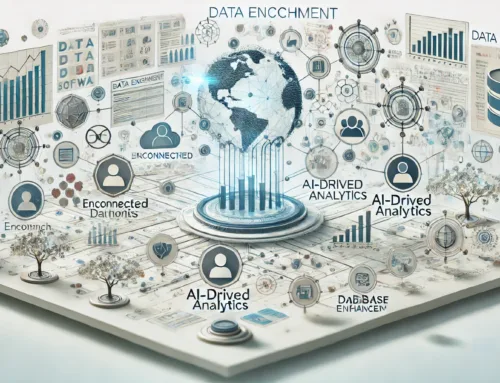You’ve invested in a data enrichment solution, but have you ensured it includes the ten essential features in your data enrichment solution for optimal performance? From seamless integration to predictive analytics, each feature plays a vital role in enhancing your data management capabilities. But what are the remaining must-have components that can truly elevate your data enrichment solution to the next level? Explore further to unlock the full potential of your data enrichment strategy.
Easy Integration
When considering the essential components of a data enrichment solution, one key feature that significantly impacts user experience is Easy Integration. Integration flexibility and API compatibility play crucial roles in ensuring that your data enrichment solution seamlessly integrates with your existing systems. By offering a wide range of integration options and supporting various APIs, the solution can easily adapt to your specific needs and environment.
Moreover, seamless data syncing is essential for maintaining accurate and up-to-date information. Automated updates further enhance this process by ensuring that your data enrichment solution is constantly refreshed with the latest information. This not only saves time but also improves the overall efficiency of your data management processes.
Real-Time Updates
Enhancing the timeliness and accuracy of your data management processes, Real-Time Updates are a pivotal feature in any data enrichment solution. Instant updates ensure that your database is constantly refreshed with the most current information available. This feature guarantees data accuracy by providing timely information that reflects the latest changes in your dataset.
Data Cleansing Tools
Within your data enrichment solution, the utilization of Data Cleansing Tools is essential for maintaining the quality and accuracy of your dataset. These tools help streamline the process of identifying and correcting errors, inconsistencies, and duplicates in your data. Here are three key features to look for in Data Cleansing Tools:
- Automated Cleansing Processes: Look for tools that offer automated processes to efficiently clean your data without the need for manual intervention. Automated cleansing can save time and ensure a more consistent approach to data quality management.
- Customizable Cleansing Rules: Opt for tools that allow you to define and customize cleansing rules based on your specific data requirements. Customizable rules enable you to tailor the cleansing process to suit your unique dataset and business needs.
- Real-time Monitoring: Consider tools that provide real-time monitoring capabilities to continuously check and cleanse incoming data. Real-time monitoring ensures that your dataset remains accurate and up-to-date, minimizing the risk of errors.
Data Segmentation
When it comes to data segmentation, you need to focus on targeted audience segmentation to enhance your marketing efforts. By creating personalized data segments, you can tailor your messaging to specific groups, increasing engagement and conversion rates. Effective segmentation strategies are crucial for optimizing your campaigns and ensuring that your resources are utilized efficiently.
Targeted Audience Segmentation
Targeted Audience Segmentation, also known as Data Segmentation, is a crucial component of any data enrichment solution. This process involves dividing your customer base into specific groups based on various criteria to tailor your marketing strategies effectively.
Below are three key aspects of Targeted Audience Segmentation:
- Behavioral Targeting: Utilize customer behavior data to segment your audience based on their interactions with your products or services. This allows for personalized marketing campaigns that resonate with their preferences.
- Demographic Segmentation: Categorize your audience based on demographic factors such as age, gender, income, and education level. Understanding these characteristics helps in creating targeted messages that appeal to specific groups.
- Geographical Analysis: Segmenting your audience by location can provide insights into regional preferences and trends. This information enables targeted marketing efforts tailored to the unique needs of different geographical regions.
Personalized Data Segments
To enhance the granularity of your audience segmentation, consider implementing Personalized Data Segments within your data enrichment solution. Personalized Data Segments allow for customized targeting by grouping individuals based on specific attributes or behaviors. By utilizing this feature, you can create tailored segments that cater to the unique characteristics of each group within your audience.
With Personalized Data Segments, you can perform personalized outreach campaigns that resonate with each segment’s preferences and interests. This level of customization enhances the effectiveness of your marketing efforts by delivering relevant content to the right audience at the right time. By leveraging data enrichment tools to create these personalized segments, you can optimize your marketing strategies and drive better engagement with your target audience.
Effective Segmentation Strategies
Implementing effective segmentation strategies is crucial for optimizing your data enrichment solution. By utilizing customer profiling and behavioral targeting, you can enhance your marketing efforts and drive better outcomes. Here are three key strategies to consider:
- Demographic Segmentation: Divide your audience based on demographic factors such as age, gender, income, or location. This approach helps tailor your messaging to specific groups, increasing relevance and engagement.
- Behavioral Segmentation: Analyze customer behavior to create segments based on interactions with your brand. By understanding how customers engage with your products or services, you can personalize communication and offerings to meet their needs effectively.
- Loyalty Segmentation: Identify and categorize customers based on their loyalty levels and purchase history. This segmentation allows you to target loyal customers with special promotions or rewards, fostering brand loyalty and repeat business.
Implementing these segmentation strategies will enable you to deliver more personalized and targeted experiences, ultimately improving customer satisfaction and driving revenue growth.
Predictive Analytics
Predictive analytics in your data enrichment solution enables you to forecast future trends based on historical data patterns. By utilizing this capability, you can make data-driven decisions that are backed by insights generated from predictive modeling. This empowers you to proactively strategize and adapt to changing market conditions with a higher degree of accuracy.
Future Trend Prediction
Within your data enrichment solution, the capability for future trend prediction through predictive analytics stands as a pivotal component. Leveraging predictive analytics allows you to anticipate market trends and gain valuable industry insights, enabling proactive decision-making. Here are three key benefits of incorporating future trend prediction into your data enrichment solution:
- Enhanced Strategic Planning: By analyzing historical data and patterns, predictive analytics empowers you to forecast future trends accurately. This insight enables you to develop robust strategies aligned with upcoming market shifts, giving you a competitive edge.
- Improved Risk Management: Predictive analytics can identify potential risks and opportunities before they fully materialize. Understanding future trends allows you to mitigate risks effectively, optimize resource allocation, and capitalize on emerging market trends.
- Personalized Customer Experiences: By predicting future trends in consumer behavior, you can tailor your products and services to meet evolving customer needs. This level of customization enhances customer satisfaction and loyalty, driving business growth.
Data-Driven Decision Making
Utilizing predictive analytics in your data enrichment solution facilitates data-driven decision-making by providing valuable insights derived from analyzing past data trends. By incorporating predictive analytics into your data enrichment process, you can enhance decision-making by leveraging historical data to forecast future outcomes and trends. This analytical approach enables you to make informed choices based on data-driven insights rather than relying solely on intuition or guesswork.
The benefits of data-driven decision-making through predictive analytics include improved accuracy in forecasting, enhanced risk management, and better strategic planning. By harnessing the power of predictive modeling, you can identify patterns, trends, and potential opportunities within your data that may have otherwise gone unnoticed.
However, challenges such as data quality issues, integration complexities, and the need for skilled data analysts can impede the effectiveness of predictive analytics in driving decision-making processes. Overcoming these obstacles through proper data governance, advanced data integration techniques, and investing in training for your team can help maximize the benefits of data-driven decision-making in your data enrichment solution.
Machine Learning Capabilities
With machine learning capabilities integrated into your data enrichment solution, you can enhance the accuracy and efficiency of your data processing tasks. Leveraging model training and algorithm optimization, machine learning empowers your system to learn from data patterns and make predictions or decisions without being explicitly programmed.
Markdown list:
- Model Training: By continuously training your machine learning models on new data, you can ensure that they adapt to changing trends and patterns, improving the accuracy of your data enrichment.
- Algorithm Optimization: Fine-tuning algorithms based on specific use cases and datasets can significantly enhance the performance of your data enrichment solution, leading to faster and more precise results.
- Predictive Analytics: Machine learning capabilities enable your system to forecast future trends, behaviors, or outcomes based on historical data, providing valuable insights for decision-making and strategic planning.
Data Validation
When it comes to your data enrichment solution, data validation plays a crucial role in ensuring the accuracy of your information. By implementing real-time validation updates, you can maintain the integrity of your data and make informed decisions based on reliable information. Accuracy in validation is essential for maximizing the effectiveness of your data enrichment solution.
Accuracy in Validation
Enhancing the quality of your data through accurate validation is a critical aspect of any data enrichment solution. To ensure the accuracy of your data validation process, consider the following key points:
- Validation Techniques: Implement a variety of validation techniques such as format checks, range checks, and consistency checks to verify the integrity and quality of your data. These techniques help identify errors and inconsistencies in your dataset, ensuring that only high-quality data is used for analysis and decision-making.
- Error Detection: Utilize advanced error detection mechanisms like checksums, regular expressions, and data profiling to identify and rectify errors in your data. By leveraging these tools, you can automatically detect discrepancies and anomalies, improving the overall accuracy of your data validation process.
- Automated Validation Rules: Establish automated validation rules based on predefined criteria to streamline the validation process and reduce manual effort. Automated rules ensure consistent validation standards are applied across all datasets, enhancing the accuracy and efficiency of your data enrichment solution.
Real-Time Validation Updates
For a robust data enrichment solution, the incorporation of real-time validation updates is paramount. Automated verification and instant validation are essential components to ensure data accuracy and relevancy. Real-time validation updates enable the system to automatically verify and validate data as it is being entered or updated, reducing errors and ensuring data integrity.
By implementing automated verification processes, data enrichment solutions can instantly flag and correct inaccuracies, inconsistencies, or missing information in real time. This proactive approach not only enhances the quality of data but also improves overall operational efficiency by eliminating the need for manual intervention in the validation process.
Furthermore, instant validation capabilities enable users to receive immediate feedback on the accuracy of the data, allowing for timely corrections and updates. This real-time validation feature is crucial for maintaining data consistency and reliability, ensuring that only high-quality information is utilized for decision-making processes. In conclusion, real-time validation updates are indispensable for a comprehensive data enrichment solution that prioritizes accuracy and efficiency.
Quality Control Measures
Implementing robust quality control measures in your data enrichment solution is crucial for ensuring the accuracy and reliability of your enriched data. To maintain high-quality standards, consider the following key measures:
- Regular Data Enrichment Audits: Conduct periodic audits to evaluate the effectiveness and accuracy of your data enrichment processes. This helps identify any issues or inconsistencies in the enriched data and allows for timely corrective actions to be taken.
- Monitoring Data Enrichment Progress: Implement real-time monitoring tools to track the progress of data enrichment activities. This enables you to detect any anomalies or deviations from the expected outcomes, facilitating immediate intervention and adjustments to maintain data integrity.
- Quality Assurance Protocols: Establish robust quality assurance protocols to ensure that only reliable and relevant data is included in your enriched dataset. Implementing validation checks and verification processes can help weed out inaccuracies and inconsistencies, enhancing the overall quality of your enriched data.
Multi-channel Support
To effectively cater to diverse data sources and ensure comprehensive enrichment capabilities, your data enrichment solution should incorporate robust multi-channel support. Multi-channel support is essential for enhancing customer engagement and enabling omnichannel marketing strategies. By integrating various channels such as email, social media, websites, and more, your solution can collect and analyze data from different touchpoints, providing a holistic view of customer interactions. This comprehensive approach allows for personalized and targeted communication, leading to improved customer experiences and increased conversion rates.
With multi-channel support, your data enrichment solution can gather data from multiple sources simultaneously, ensuring that no valuable information is missed. This capability enables you to create a unified customer profile by consolidating data from various channels, enhancing your understanding of customer behavior and preferences. By harnessing multi-channel support, your solution empowers you to deliver relevant and timely messages across all touchpoints, driving effective omnichannel marketing strategies and maximizing customer engagement.
Scalability
With the foundation of robust multi-channel support in place, the focus now shifts towards examining the critical aspect of scalability within your data enrichment solution. Scalability is vital to ensure your system can handle increased data volumes efficiently. Here are three key considerations to maximize scalability:
- Data Enrichment Efficiency: Scalability directly impacts the efficiency of your data enrichment processes. A scalable solution can quickly adapt to processing large datasets without compromising speed or accuracy.
- Scalability Challenges: Understanding potential scalability challenges is crucial. Factors such as increased data sources, varying data formats, and growing customer bases can strain an inadequate system. Anticipating and addressing these challenges proactively is essential for seamless scalability.
- Future Growth: Scalability is not just about handling current data loads but also about preparing for future growth. A scalable data enrichment solution should be able to accommodate expanding data needs without requiring significant retooling or causing disruptions.
Frequently Asked Questions
How Does the Data Enrichment Solution Ensure Data Privacy and Security?
To ensure data privacy and security, the solution implements compliance measures, robust encryption, and strict user permissions. It prioritizes data protection by continuously monitoring access and usage, safeguarding sensitive information from unauthorized access or breaches.
Can the Solution Handle Large Volumes of Data for Enrichment?
Yes, the solution can handle large volumes of data for enrichment with scalability and top performance. It ensures data validation and accuracy, allowing you to process extensive datasets efficiently and accurately, meeting your business needs.
What Level of Customization Is Available for Data Enrichment Processes?
You can have complete control over customization with various options available in your data enrichment processes. Automation tools and robust workflow management systems provide user-friendly interfaces for tailoring enrichment to your specific needs and preferences.
Does the Solution Offer API Access for Seamless Integration With Other Systems?
Yes, the solution provides API access for seamless data integration capabilities and enhances system compatibility opportunities. This feature allows you to easily integrate with other systems and maximize the efficiency of your data enrichment processes.
How Does the Solution Handle Data Enrichment for Non-Traditional Data Sources?
When handling data enrichment for non-traditional sources like unstructured social media data or IoT sensor data, the solution uses advanced algorithms to extract relevant information. It then organizes and enriches the data for comprehensive analysis.




